|
Ladakh is a mountainous place located
in Jammu & Kashmir, Northwest India. It is the largest and least
populated area of Jammu & Kashmir. Leh is the district area of
Lada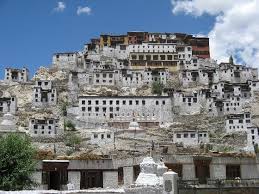 kh
located in Jammu & Kashmir. The population is a mixture of
Buddhist and Muslims equally. kh
located in Jammu & Kashmir. The population is a mixture of
Buddhist and Muslims equally.
Leh Ladakh architecture is much influenced by Tibet style of
building. The residential buildings and the monasteries both are
very similar to Tibetan style. Tour of Ladakh starts with
exploring Buddhist monasteries. Ladakh is very much famous for the
distinguished style of monasteries. Some of the popular
monasteries of Ladakh include Alchi, Hemis Monastery, Likir,
Spituk, Thikse, Sankar etc.
There are enough opportunities for adventure sports such as
trekking, river rafting, mountain climbing, cycling, camel safari,
yak safari etc. in Ladakh. You can also enjoy exotic wildlife
species like Yak, Nyan, Urial, Churu, Snow Leopard etc. These wild
animals live on minimal vegetation, bitter cold, poor habitat and
rock landscape.
Attraction
Shanti Stupa
Built by a Japanese Bu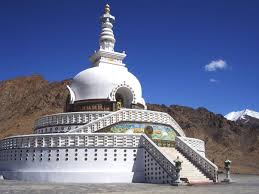 ddhist
order as part of a global peace drive that constructs Peace
Pagodas, this domed stupa was inaugurated by His Holiness the
Dalai Lama in 1985. The pristine white stupa& magnificent even by
moonlight& offers spectacular views of the sunrise, sunset and the Zanskar range. ddhist
order as part of a global peace drive that constructs Peace
Pagodas, this domed stupa was inaugurated by His Holiness the
Dalai Lama in 1985. The pristine white stupa& magnificent even by
moonlight& offers spectacular views of the sunrise, sunset and the Zanskar range.
Leh Palace
This almost forgotten monument was built in the 17th century by
King Singe & Lion& Namgyal as the nine-storied royal residence.
Meander your way through massive buttressed walls and overhanging
wooden balconies to soak up some old world charm. Currently, the
Leh Palace is being used as the headquarters of the Indian
Government's archaeological conservation organisation.
Sankar Gompa
This is small bu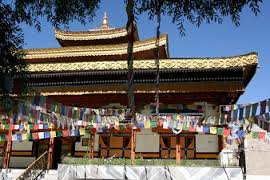 t
more interesting place to visit than the Leh Gompa and can easily
be visited on foot. The Sankar Gompa is an under Gompa of Spitok
Gompa. At the most only 20 monks live here and few are permanently
in residence although the monastery itself is fairly active. Thus
the Gompa is only open to the public from 7.00 am to 10.00 am and
from 5.00 to 7.00 pm. It is, however, well lit, so an evening
visit is worthwhile. At these times the monks will welcome the
visitors and may offer one yak butter tea, 'Tsampa' and boiled and
spiced mustard plant. t
more interesting place to visit than the Leh Gompa and can easily
be visited on foot. The Sankar Gompa is an under Gompa of Spitok
Gompa. At the most only 20 monks live here and few are permanently
in residence although the monastery itself is fairly active. Thus
the Gompa is only open to the public from 7.00 am to 10.00 am and
from 5.00 to 7.00 pm. It is, however, well lit, so an evening
visit is worthwhile. At these times the monks will welcome the
visitors and may offer one yak butter tea, 'Tsampa' and boiled and
spiced mustard plant.
Leh Gompa
The Leh Gompa stands high above the palace and also overlooks the
ruins of the older palace of the King of Tagpebums. The Red Gompa
also known as Namgyal Tsemo Gompa was built in 1430 by King
Gvags-Pa-Bum-Ide and has a fine three-storey high seated Buddha
figure flanked by Avalokitesvara on the right and Manjushri on the
left. In all there are three Gompas at the top of the hill, the
topmost one is in a very ruined condition but offers extremely
fine views over Leh and the surrounding countryside. To the right
of the palace one can see a Buddha painted on the rocks, a remnant
of an earlier monastery.
Other Leh Gompas
There are a number of les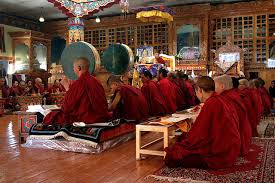 ser
Gompas in the old town of Leh - such as the Guru Lakhang to the
left of the palace, beneath the large Chorten. The Chamba Lakhang,
south of the palace, and the Chenrezig Lakhang, to the southeast,
are similarly less famous since they contain little of interest
compared to other more splendid Gompas around Leh. In the centre
of Leh the Buddhist association of Ladakh in 1957 built the new
monastery or Gompa Soma or Jokhang. It contains an image of the
Buddha Sakyamuni that was brought form Tibet. Meetings of the
Buddhist association are held in this monastery. ser
Gompas in the old town of Leh - such as the Guru Lakhang to the
left of the palace, beneath the large Chorten. The Chamba Lakhang,
south of the palace, and the Chenrezig Lakhang, to the southeast,
are similarly less famous since they contain little of interest
compared to other more splendid Gompas around Leh. In the centre
of Leh the Buddhist association of Ladakh in 1957 built the new
monastery or Gompa Soma or Jokhang. It contains an image of the
Buddha Sakyamuni that was brought form Tibet. Meetings of the
Buddhist association are held in this monastery.
Leh Fort
The Leh fort, built by Zorawar Singh, contains three temples but
cannot be visited because it is within the military camp area.
The Bazaar And Old Town
After settling into a hotel or guesthouse, most visitors spend
their first day in Leh soaking up the atmosphere of the bazaar.
Sixty or so years ago, this bustling tree lined boulevard was the
busiest market between Yarkhand and Kashmir. Merchants from
Srinagar and the Punjab would gather to barter for Pashmina wool
brought down by nomadic herdsmen from western Tibet, or for raw
silk hauled across the Karakorams on Bactrian camels. These days,
though the street is awash with kitsch curio shops and handicraft
emporiums, it retains a distinctly central Asian feel. Clean
shaven Ladakhi Lamas in sneakers and shades rub shoulders with
half bearded Baltis from the Karakoram and elderly Tibetan
refugees whirring prayer wheels, while now and again, snatches of
Chinese music crackle out of the shopkeepers transistor radios. At
the bottom of the bazaar, women from nearby villages, stovepipe
hats perched jauntily on their heads, sit behind piles of
vegetables, spinning wool and chatting as they appraise the
passers by.
Namgyal Tsemo Gompa
Standing on a hill above the city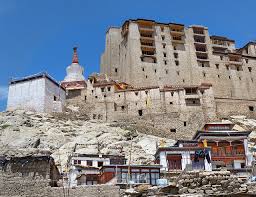 behind the Leh Palace is the NamgyalTsemo Gompa& Temple of the
Guardian Deities& which houses a three-story high, gold idol of
Maitreya Buddha(also known as the Laughing Buddha). Built in 1430,
this temple is a part of a fort, and the best time to visit is in
the wee hours of the windy morning, during the daily prayers.
behind the Leh Palace is the NamgyalTsemo Gompa& Temple of the
Guardian Deities& which houses a three-story high, gold idol of
Maitreya Buddha(also known as the Laughing Buddha). Built in 1430,
this temple is a part of a fort, and the best time to visit is in
the wee hours of the windy morning, during the daily prayers.
The Monastery Circuit
Dotted along the Indus, you can find a grand number of Buddhist
Monasteries; namely Shey, Thiksey, Hemis, Stakna and Matho. Each
of these holy sites offers a little something unique for the
day-tripper, from castle locations and ancient Buddhas to the
largest thangka in the world.
MUSEUM
Stok Palace Museum
Stok Palace has been the official residence of the Ladakhi royal
family for the last two hundred years& since they were ousted from
Leh and Shey. The only part of the 77-room Palace that is open to
tourists has now been converted into a museum which houses a
collection of the royal family& s attire, thangka paintings, prayer
instruments and crowns.
OUTSIDE THE CITY
Hemis National Park
Bounded by the great Indus and spread over nearly 4,440 sq km, the
Hemis National Park is Ladakh& s wild-and-hidden wonder. About 200
snow leopards call this park their home along with Asiatic ibex
and Himalayan Griffon vultures. |